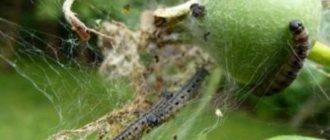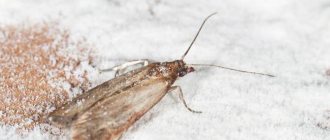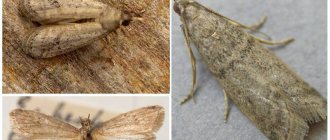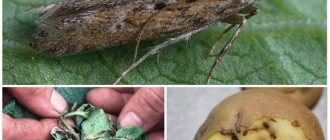Today, science knows over 3 thousand species of moths, some of which are harmful. In the Central region of Russia, parasitic moths in indoor environments are most often found either in things or in products, so they can be conditionally divided into food moths and clothing moths. Why conditional? The fact is that these can be several different types of moths, which only slightly differ from each other in some biological features, however, if you do not have an entomological interest in this issue and are only trying to find out more about how to get rid of the pest, information about subtle species differences have no practical value.
What do food and clothes moths look like and by what signs can they be distinguished from other flying insects in the house?
What does a thing moth look like (photo)
Clothes moth.
Feeding house moths
In general, the moth is a rather capricious “gourmet” and a supporter of natural food, especially wool products. So the fur coat will be no less dearly loved by the parasites than by its owner. The fact that they express their tender affection in different ways is another matter. But if there is a shortage of “healthy” food, then the insect can switch to synthetics. Maybe with less enthusiasm, but her appetite does not suffer from this.
What about cotton? Yes, and yes again. The pest loves cotton items very much, so items made from 100% cotton will be attacked first . It’s a good idea to treat fabric before storing clothes in a closet, especially for a long time, until the next season.
Moths use water to drink. She doesn’t drink anything else, unlike the same cockroaches who are big fans of intoxicating drinks.
Main characteristics of the pest
Name: House moth Lat.:
Tineola bisselliellaClass: Insects - Insecta. Order: Lepidoptera - Lepidoptera. Family: True moths - Tineidae.
| Habitats: | cabinets, furniture |
| Dangerous for: | fabrics, furs, upholstery |
| Means of destruction: | traditional methods, chemicals, traps. |
Moth caterpillars.
Many people mistakenly believe that if their home is kept in order and clean, then these pests are not afraid of them. But in vain, because moths do not start from dirt.
She loves things made from natural fabrics such as wool and fur. She does not disdain cereals or other loose ingredients left unattended in the kitchen.
Such components are present in every home, so you need to always be on guard. In addition, if there is a moth in a neighboring apartment, then it is possible that it can get into the home through open doorways, vents, or cracks.
You can bring it with purchases from the store, with things or furniture that were used by other people.
What does it look like and where does it lay eggs?
The clothes moth looks like a fairly large butterfly. Its wingspan reaches 23 millimeters. The color of the wings is predominantly sandy, with a purple tint at the base.
She lays eggs in dark, hard-to-reach places, in folds of fabric, under collars and cuffs, in pockets, and in the recesses of textile seams.
Life cycle
The complete development cycle from egg to butterfly takes from one to two and a half years. Having hatched from the pupa, the butterfly immediately looks for a sexual partner and mates. In two weeks she lays about 50 eggs. After laying eggs, which takes seven days, the female lives for a few more days and dies. The male continues to mate until the end of his life.
Life cycle of a moth.
Damage
Moth damage on clothing.
Adult larvae crawl on clothes and furniture. The most dangerous are only the larvae that hatch from the eggs. They destroy and chew everything in their path, even synthetics and plastic bags.
Once the toothy larva has reached the item, all that remains is to throw it away. Such things, as a rule, cannot be restored.
What does it eat?
Clothes moths usually live in closets, furniture, attics, pantries, and anywhere there are fabric-upholstered items and clothing. Their favorite food is fur coats, woolen items, linen, cotton, natural angora, silk, and cashmere.
Special differences between moths and butterflies
There are both primary and secondary signs of the absence of a special proboscis in a flying pest:
- The primary toothed insects retained an underdeveloped oral apparatus, which did not disappear over a long period of evolution;
- Adult moths of the second type have completely lost such an organ, since there is no need to consume food at a specific stage of development.
The difference between caterpillars and butterflies is especially pronounced. This natural feature increases the chances of survival of the species several times due to the lack of competition in the choice of food. In nature, moths develop clearly according to chronology, since sometimes a lack of nutrients contributes to prolonged growth. In houses with an optimal microclimate, the parasite has all the conditions for accelerated ripening, and a constant temperature within 23-25 degrees eliminates the need for wintering. This is why food moths in an apartment transform from a larva into a butterfly in no more than four months.
As an adult, the butterfly does not need food supply, but the proboscis would simply get in the way. During the week of their existence, flying pests mate and lay eggs in secluded places. The larvae begin a new development cycle and actively seek food for early pupation.
The structure of the caterpillar is perfectly adapted to grow and gain weight in the shortest possible time. At this stage of development, the larvae of moths and butterflies have the same gnawing mouthparts - an excellent device that allows you to quickly cut off the hairy parts of fur from a fur coat and grind the fibers of natural fabrics on clothing.
How to get rid of clothes moths
It is quite difficult to remove clothes moths. Moreover, considering the fact that caterpillars can go without food for a month. There are folk, chemical and professional means of insect control.
Regular monitoring
In order to minimize the risk of invasion, regular inspections are carried out in cabinets and shelves. Both butterflies and larvae cannot exist without giving themselves away. In their habitats there will certainly be damaged areas of tissue, gnawed pieces of fur, threads of cobwebs, cocoons and feces.
If you suspect the presence of unwanted guests, you should react immediately, otherwise trouble cannot be avoided.
Preventing or reducing infestations
Cleaning a living space infested with clothes moth larvae should be carried out with special care.
- It is necessary to pay attention to hard-to-reach places: behind radiators and ventilation holes, under baseboards and wardrobes.
- Wipe shelves and furniture with a special disinfectant.
- When using a vacuum cleaner, upon completion of work, you must immediately dispose of the contents of the dust collection bag so that the larvae and eggs that get there cannot return again.
If moths are found in a closet, you should remove all items from there and wash all surfaces.
Protecting things in the closet
Sachet for the closet.
Clothes and other items left in the closet without proper care are most susceptible to insect attacks.
Therefore, they should be stored in clean, dry form, in sealed containers, pre-treated with natural repellents, for example, mint, lavender, wormwood, or use special chemicals, dichlorvos.
Freezing and heating
Moths do not like low or high temperatures.
Moth butterflies die when there is a sharp change in temperature, and it does not matter in which direction this difference occurs. This could be temperatures above 50 or below 20 degrees Celsius.
The product, previously placed in plastic packaging, is either fried in an oven or frozen in the freezer. It all depends on the type of fabric: if it is not afraid of these types of processing, then you can safely take them into service.
Dry cleaning will help get rid of moth larvae.
The contents of the closet are reviewed for damage, and surviving clothes are washed and fried at high temperatures. Bright sunlight is not a moth's best friend; it dies in the light.
Washing is done at a temperature of at least 50 degrees and for a duration of at least half an hour. Textiles that cannot be washed at high temperatures should be dry cleaned.
Traps
Sticky trap.
Another method of control is glue pheromone traps. This is the simplest, most accessible and relatively cheap method. The principle of its operation is very simple.
The female follows the smell emanating from the trap and sticks her paws to the glue, gets stuck there and dies. You can purchase it at any specialized institution.
Moth Reproduction
Like the majority of butterflies, this family also lays eggs. Moth eggs are very small, only 0.4-0.5 mm. The quantity of one clutch is 50-80 pieces. The female hides it in the most secluded corners to protect it from detection. These can be places near pockets, flaps, collars, lapels of woolen items, blankets, shawls, hats, stored for a long time in the depths of closets, chests of drawers and chests. To detect a cluster of embryos, you will have to work hard, rummaging through items of clothing and household items that have not been used for a long time .
The next stage is the caterpillars. Having hatched, the larvae begin to feed on the tissue surrounding them. The sooner the nest is discovered, the sooner you will get rid of the pest using special means. It is better to give an expensive item for professional processing.
Preventive measures
Folk remedies are often used as prevention.
Repellent plants are able to repel insects and moths with their specific aroma.
Their effect is longer than that of chemical drugs, but they are less dangerous to the health of people and pets. These include tobacco, garlic, vinegar, geranium, lily, mint, lavender, rosemary, citrus peel and many others.
Follow this link to learn more about all the ways to get rid of moths.
Difficulties in killing moths
The shelves of hardware stores are filled with insect repellents. However, modern pests can extremely quickly adapt to what they are trying to poison them with. This complicates the disinfestation procedure. You have to change medications regularly. And despite all this, final victory rarely comes.
In view of this, it is easier to take care of preventing the appearance of pests. Preventive measures will vary depending on the type of moth. Recommendations on the algorithm of actions in your situation should be obtained from specialists.











